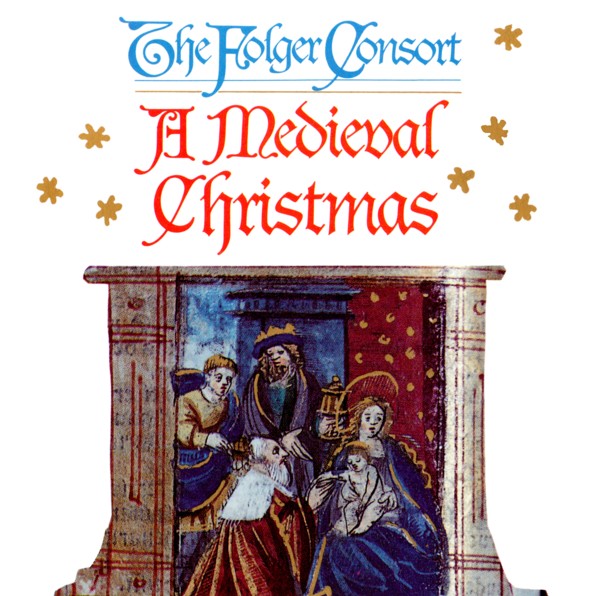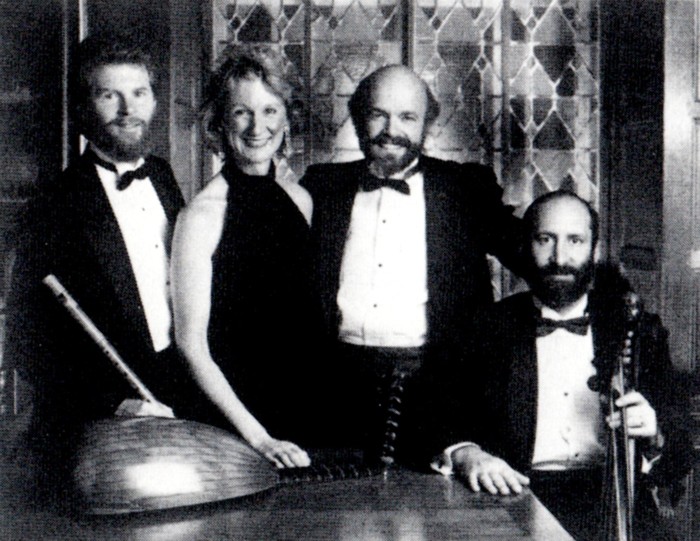
medieval.org
worldcat.org
Bard BDCD 1-91 06
1991
A Medieval Christmas

medieval.org
worldcat.org
Bard BDCD 1-91 06
1991
A Medieval Christmas
The
Folger Consort presents a stirring selection of Christmas music from
late 11th-century southern France to 15th-century England.These are
pieces of wonderful variety — intimate and inspiring, courtly and
rustic, complex and engagingly simple. Yet this rich diversity of music
shares the telling of the Christmas story.
Aquitanian vers and Las Huelgas Manuscript
1. Natus est rex [6:10]
2. Noster cetus psallat letus [2:26]
3. Angelorum laude digna [2:13]
Hu 60
4. In sapiencia [5:36]
Hu 62
5. Benedicamus Domino [1:58]
Hu 37
6. Ave caro [1:05]
Hu 136
7. Psallat chorus [1:47]
Hu 123
13th-Century England
8. Excelsus in numine [1:43]
9. Angelus ad virginem [3:20] ‘Gabriel, fram heven-kinge’, several settings
10. Ductia [1:28]
11. Ductia [1:42]
Trecento · Italy
12. Benedicamus Domino [1:07]
13. Cristo e nato [2:57]
14. Benedicamus Domino [1:29] PAOLO da FIRENZE
15. Ave, Dei genitrix [3:57]
16. Kyrie [1:32]
17. Gloria [2:19] EGARDUS
18. Salutiam divotamente [1:58]
15th-Century English Carols
19. Nowell; Dieu vous garde [2:59]
20. Ah, my dear son [4:45]
21. Ave rex angelorum [1:46]
22. There is no rose [3:10]
23. Lullay, lullow [1:17]
24. Nowell, Nowell: Tidings True [3:07]
25. Nowell sing we [2:23]
Note: unless marked, compositions are anonymous

THE FOLGER CONSORT and Johana Arnold / photo: Mary Noble Ours
The
Folger Consort is ensemble-in-residence at the Folger Shakespeare
Library, a leading center for medieval and Renaissance studies in
Washington, D.C. Founding members of the Consort are Robert Eisenstein, rebec, vielle, recorders,
Christopher Kendall, lute, harp, mandora, and Scott Reiss, recorders, psaltery, percussion.
Joining the Consort on this recording are Johana Arnold, soprano, and Tina Chancey, rebec, vielle, kamenc, recorder.
For
further information on the Folger Consort, contact the Division of
Museum and Public Programs at the Folger Shakespeare Library, 201 East
Capitol Street, S.E., Washington, D.C. 20003 (202) 544-7077; fax (202)
544-7520.
Werner Gundersheimer, Director, Folger Shakespeare Library
Janet Alexander Griffin, Producer, Folger Consort
Susanne Oldham, Manager, Folger Consort
DDD
Recorded in Abbey Chapel, Mount Holyoke College, South Hadley, Massachusetts
Recording and editing engineer: Curt Wittig.
Producer: The Folger Consort
Edit producer: Scott Reiss
Session producer: Ronn McFarlane
Designer: Jeanne Krohn
© and ℗ 1991 Bard Records.
All rights reserved. Unauthorized duplication is a violation of applicable laws. Made in the U.S.A.
The front cover illustration is from a book of hours presented by Anne of Cleves to Henry VIII;
Enchiridion Preclare Ecclesie Sarisburiensis (Paris, ca.1533)
in the collection of the Folger Shakespeare Library.

This collection of Christmas music spans the late 11th century in
southern France to the 15th century in England. The selections show a
great variety of musical styles, learned and rustic, complex and
engagingly simple; yet most of these pieces have the telling of the
Christmas story in common. It is striking that a 14th-century laud from
Florence can appeal to us in some of the same ways as a much later carol
from England. While almost all of the works you will hear, both
instrumental and sung, are directly connected to Advent or Christmas
itself, we have rounded out the program of carols and liturgical pieces
with a few instrumental selections which seem to fit the spirit of the
season. We hope the result is a pleasing sort of international musical
smorgasbord, a holiday buffet for the ears.
Natus est rex and Noster cetus psallat letus are 11 th-century vers,
non-liturgical religious songs that survive in a manuscript from the
great library of the Abbey of St. Martial in Limoges, south-central
France. Because this area, home to the first troubadours, was important
in the development of secular song in the vernacular, its major role in
Latin song and early polyphony is often not realized. How these pieces
were performed and in what context are open questions. They may have
been sung by monks for recreation or as additions to liturgical
services. It is amazing how many of the St. Martial texts refer to
"harmonia" and "symphonia," suggesting the use of instruments and simple
polyphony in performance. The second of our two vers
is polyphonic — the first line of music creates a two-part
texture with the second line, the third with the fourth, and so on.
The
manuscript preserved at the Castilian monastery of Las Huelgas dates
from the 14th century. It is an anthology of earlier music, some as old
as the 12th century. Many pieces in this large source belong to the
French and particularly Parisian repertory of the 13th century, but
there are numerous examples of native Spanish work as well. One
interesting thing about the Las Huelgas codex is that it is written in
much less ambiguous notation than most earlier sources containing
similar music. All of our examples, except the beautiful prosa, In sapiencia, are polyphonic, and demonstrate the powerful and beautiful effects these composers could achieve with very limited means.
The English pieces performed here instrumentally are not really Christmas pieces at all. Excelsus in numine
is a motet in honor of St. Thomas of Canterbury, although the radiant,
luminous quality of the piece reflects the mood of the season. The
concluding English works are two of three such pieces preserved in modal
notation without texts. They have always been presumed to be
instrumental works, probably dances. The fact that they are virtually
indistinguishable from parts of texted conducti of the time encourages some of us to look to the large conductus repertoire as a way to extend the very limited surviving body of medieval instrumental music. Angelus ad virginem (Gabriel, fram heven-kinge),
in addition to being an Advent song, has the distinction of being the
one piece of music that has a direct association with Geoffrey Chaucer.
The dandy young scholar in "The Miller's Tale" sings it to the
accompaniment of a psaltery in order to charm his lady visitors. There
are several surviving versions, all of which may be heard here.
Although
we usually think of 14th-century music as predominantly polyphonic, it
is worth noting that polyphony was the exception rather than the rule in
most churches in Italy during this time. It was cultivated only by a
very small circle of musicians and cognoscenti. The
instrumentally performed works in this group are from the very few late
14th-century Italian sources of liturgical polyphony, and show a decided
French influence. The opening Benedicamus Domino is in a
style more appropriate to the 13th century, and probably does date from
that period. Paolo's setting of the same text is the only one of our
polyphonic selections written in the style of Italian madrigals of the
time. The Kyrie and Egardus' Gloria are much more like French mass movements. The sung tunes are laude,
that is, popular, folk-like songs which may have been used in street
processions. Melodically, these engaging pieces seem to reveal the
influence of the troubadours, Gregorian chant, and perhaps folk song. Laude
were used, if not sometimes written, by the wandering groups of
penitents which arose because of the devastating wars and plagues
between 1250 and 1350. These people sought to atone for the sins of the
world by flagellating themselves, as well as by singing. Our examples,
fortunately, are celebratory in nature, so we need not imagine tortuous
original performances.
In early 15th-century England, the Church
had by no means completely succeeded in its struggle against native
paganism. Especially among the common people, customs and beliefs from
the old religion were still maintained. The medieval Church dealt with
this problem in many ways. Some customs, such as the hanging of wreaths
of mistletoe and ivy, were simply absorbed and became integral parts of
popular Christianity. To reach the largely illiterate masses, however,
the Church had to use every possible attraction. Important feasts,
especially Christmas, were made as elaborate and eye-catching as
possible, with colorful processions and much music to ornament the
liturgy. The first Christmas carols have their origins here. Their basic
purpose was to involve the people in the Church through instructive
texts, beautiful melodies, and dance-like rhythms. The word carole in
previous centuries referred to a dance song, and the dance-like quality
still seems present in many of these 15th-century examples. At any rate,
the anonymous composers of these carols certainly must have achieved
their aims. The simple, warm beauty and lively motion of these songs
capture perfectly a Christmas spirit that has not changed since the 15th
century.
Robert Eisenstein

medieval.org
worldcat.org
cdbaby.com
Bard 837101 4415 3 7
2007
Digitally remastered with four bonus tracks
from Sing heigh, Ho! Unto the green holly!
before 'old' track#1, Natus est rex:
1 • Lux Hodie...orientis Partibus [2:21]
after 'old' track #25, Nowell sing we:
27 • Noel, Nowell: I Am Here, Sire Christesmas [2:14]
28 • Abide [1:05]
29 • The Boares Head [3:12]